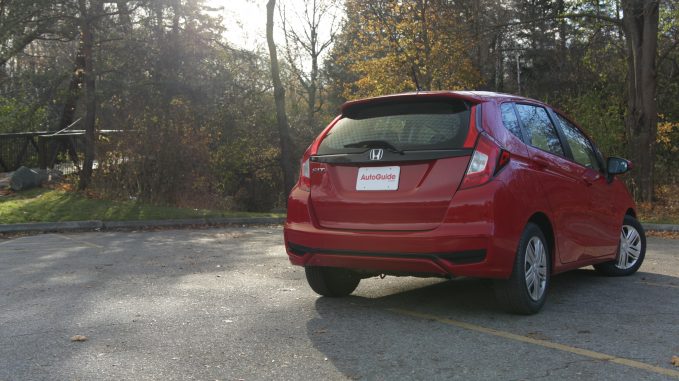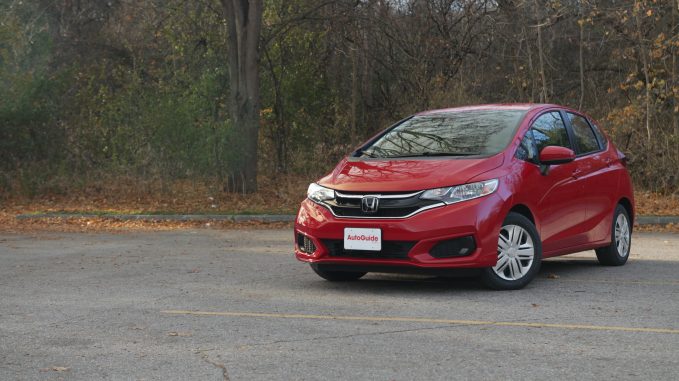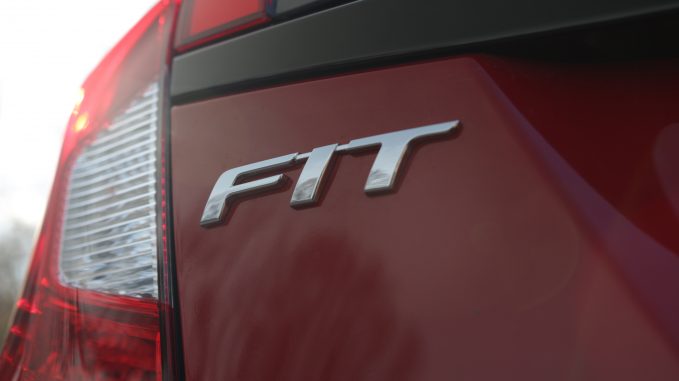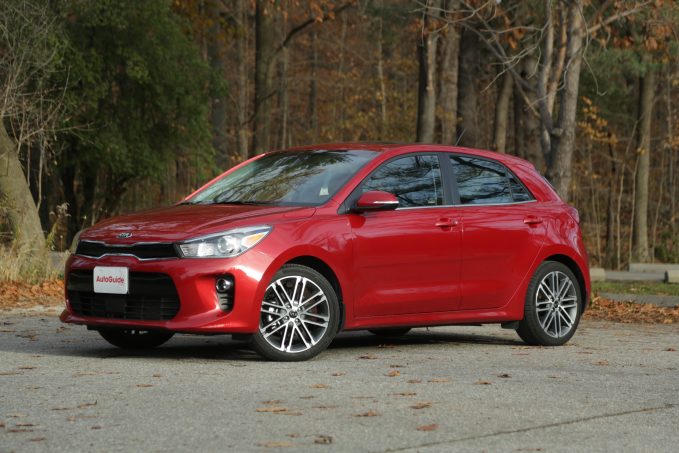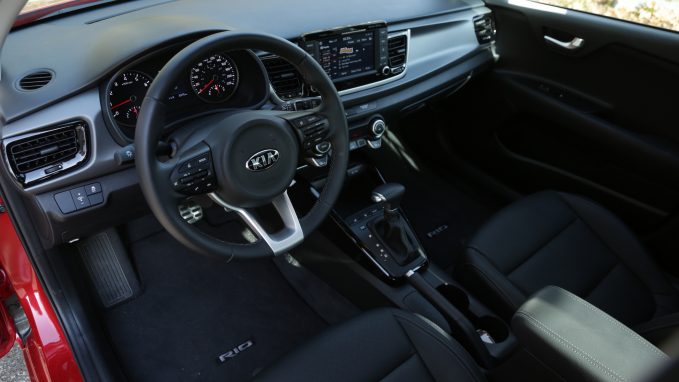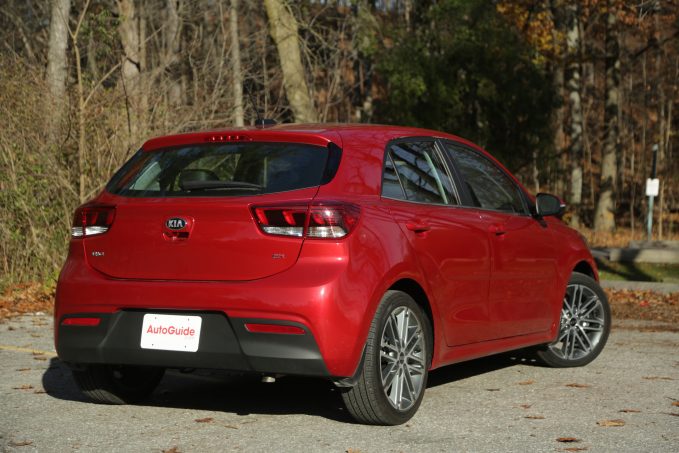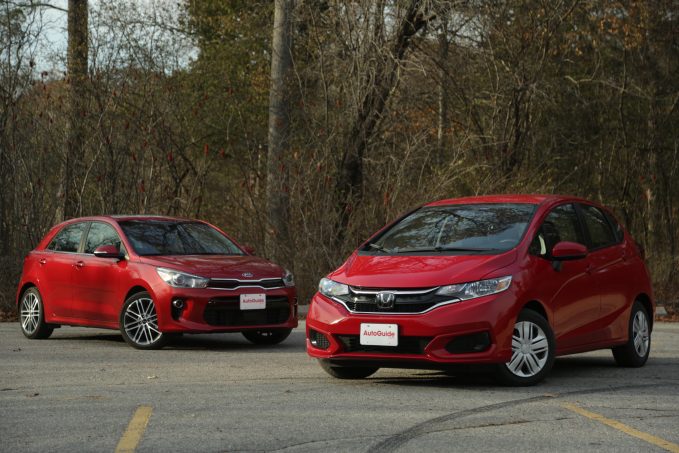It may be hard to find a really bad car these days, but it might be even more difficult to find a car that’s attractively affordable. We have two cars here that swing in under $20,000 and it’s weirdly exciting to pit them against each other.
The fully loaded Kia Rio EX hatchback maxes out at under that price point and the Honda Fit LX we have also squeezed under that price tag. But which one is the better buy? It’s not always a clear-cut answer because some buyers might want the most car for the money, while others will want a car that doesn’t feel as low cost as it actually is.
Tech and Cargo Space
The Honda Fit gets a pretty significant refresh this year. Our tester is the LX model, but with the added functionality of the Honda Sensing suite of safety and driver assistance technology, it swings in at just under $19,000 — and you get a lot of car for that price.
Get the Flash Player to see this player.
The big story with this little car is that you get some serious driver assistance and safety features in a car that’s typically a bare-bones option and the most affordable item in the showroom. But now with the Honda Sensing package, you can get high-tech equipment that used to be reserved for the most luxurious, expensive cars out there. This Honda Fit now has adaptive cruise control and lane keeping systems that are both handy and easy to use. There’s also a forward collision warning system that will appeal to a lot of nervous drivers. These features aren’t available on the Rio except the automatic emergency braking, which is only available on the most expensive model.
That highlights one of the important aspects of the Honda Fit. This car can appeal to so many different types of buyers. Due to the low price, a good chunk of buyers is likely young drivers and first-time car owners, who will appreciate the ease of driving this subcompact with its excellent visibility and thoughtful features. But the Fit will also catch the eyes of adventurous types who can put the multiple folding seats to good use for gear like camping equipment or bicycles. But then even older folks who don’t want to climb into a big car can find a reason to buy a Honda Fit. This car can accommodate all those kinds of owners and for a low price too.
Besides the price tag, the Fit has an incredible amount of cargo space with 16.6 cubic feet behind the rear seats, and over 50 cubes when the rear seats are folded, which makes this small car as versatile as a crossover. It’s also very accommodating for passengers as well with more passenger space than what’s found in the Kia.
ALSO SEE: 2018 Toyota C-HR vs Honda HR-V Comparison
However, the one thing it’s lacking is sex appeal. There’s nothing cool about its looks and it reminds you that you’re on a budget. This LX model has wheel covers and really doesn’t stand out. Additionally, the interior is full of hard plastics and it’s not that inspiring. Additionally, small things are irksome. For example, the armrest is a bit low and there’s a weird slant to the ones on the door panel. The infotainment system isn’t as pretty and responsive as the Kia’s, but fortunately, it comes with Android Auto and Apple CarPlay support. I also like that the Android Auto navigation instructions appear on the gauge cluster, which is really cool and kind of rare in the industry.
Honda On the Road
On
the road, the 1.5-liter four-cylinder engine and CVT work as an effective combination. It’s capable of getting 36 mpg combined, which is four more mpg than the Rio’s combined fuel economy rating. Drivers will find it easy to get a lot of mileage in the Fit, but there’s also an “Econ” button to make that process even easier.
However, as expected with cars in this class, it’s not the most fun to drive, even though it has an impressive (for its class) 130 horsepower and 113 pound-feet of torque. You’ll need patience to get anywhere, so plan ahead and try not to be in a hurry. It’s also an awfully loud experience. Honda says it has improved the acoustics and noise insulation in the Fit, but I’m not convinced (although the winter tires might be to blame).
Steering is nice and light, which leads to a nimble-feeling car, but the suspension is a bit off, never feeling really planted or as confident as the Kia.
After testing these two cars back-to-back, the Fit still feels very much the same as it did a few years ago. That’s why we’ve recommended it a number of times since then. It’s extremely efficient and has a copious amount of room, which is a huge asset.
Compare Specs
Handsome Rio Doesn’t Back Down
But the Rio is all new and has a lot going for it to take on the always top-of-the-food-chain Fit.
First things first: this is a fully loaded Kia Rio EX, and it costs about $800 more than that Fit LX with Honda Sensing. That’s a big deal because the fully loaded Fit would cost you more than $22,000.
As a result, though, this Rio is well equipped and looks really sharp. The design team at Kia did a really good job of making a sleek-looking subcompact, with the car’s stylish wheels meshing well with the rest of the chrome accents. There are flashy daytime running lights and it’s impressive that Kia managed to make a subcompact car look cool.
The interior is also well sorted out, with the controls and layout looking similar to what you’d find in other Kia vehicles like the Forte and Optima. The Rio really shines in terms of design and, in this trim, it doesn’t feel or look like a budget car.
Sure, there are some hard plastics in here, but there are a leather steering wheel and shifter to help to class up this cabin. Overall, the car feels high-end and well put together. And while this car doesn’t have adaptive cruise control or lane departure warning, it does feature automatic emergency braking. Our Canadian-spec model also comes with a few great features including heated seats and a heated steering wheel.
The Rio also comes with a slightly nicer interior material. It’s not quite leather, but it feels more luxurious than cloth, and that’s a pretty big win for a subcompact car buyer. Finally, the car features a better infotainment system, which also has Android Auto and Apple CarPlay support.
The major downside to the Rio compared to the Honda Fit is the lack of space, especially in the rear of the car. While it’s better outfitted, having less space is a serious drawback.
A Different Class of Car on the Road
Where the Kia really excels is the driving experience. The first thing you notice is that it is much quieter than the Fit. It also feels much smoother and responsive than the Honda. This is especially true with the steering and suspension, which makes the car feel more planted and confidence inspiring.
Like the Fit, the engine is nothing special. The 1.6-liter four-cylinder makes as much pow
er as the Honda, meaning there’s 130 horsepower on tap but a bit more torque. The six-speed automatic is also pretty good. There’s a sport mode here that makes the transmission extra happy to change gears, and pushing this car is actually kind of fun, something I wasn’t expecting at all.
The fuel economy is lacking compared to the Fit, with a combined figure of 32 mpg.
The Verdict: 2018 Kia Rio vs Honda Fit
This comparison paints a picture of two really different and good cars. The Rio elevates subcompact cars with its handsome looks, better driving dynamics, and nice interior. If you don’t want to be embarrassed driving a subcompact, then this is your best bet.
But if you want a subcompact that can do it all, the Fit is the one for you. It’s extremely spacious and liveable. It’s also very good on gas and at this price point, it offers just about everything you need in a small car. The only thing holding it back is the fact that it’s just not as fancy or good to drive as the Kia. But if you want more car for the money, the Fit is a perfect choice.







